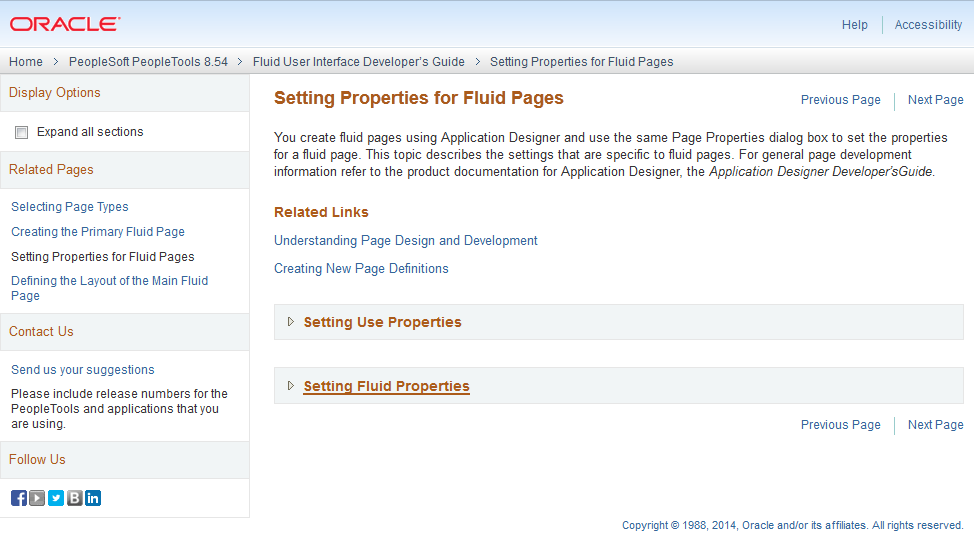Navigating the PeopleSoft Online Help
The PeopleSoft Online Help website provides several different types of pages and universal navigation features to help you quickly find the information that you need.
Note: The examples on this page may look slightly different on mobile devices. The PeopleSoft Online Help website uses responsive web design techniques to alter the layout for any sized screen, from desktop monitors to smartphones. For example, on smartphones, regions of the page automatically change position to reduce the need to pan and zoom to read a page.
Click a link in the universal navigation header to access the search page, help, and accessibility information for the PeopleSoft Online Help.
Use the breadcrumb links, which appear below the universal navigation header, to know your location in the help system and to navigate up through the navigation pages.
Image: Universal Navigation Header and Breadcrumbs
This example illustrates the universal navigation header and breadcrumbs that are described in this section.

Use the portlets on the left side of every page in the help system to perform common tasks related to the help.
Note: On smartphones in portrait mode, the portlets appear above (not to the left of) the main content on the page. Swipe down to view the main content.
You can access the following portlets on all pages, except as noted:
|
Field or Control |
Definition |
|---|---|
| Search |
Search for text within all of the files in the product family. Click the Advanced Search link to access additional search options, which vary depending on how your help administrator has configured the system. |
| Display Options |
Select or deselect the check box to expand or collapse all sections within the tree structure on a navigation page to make the page easier to navigate. This portlet appears only on pages with expandable and collapsible sections. |
| Related Pages |
Navigate to related help pages or external websites, such as My Oracle Support. |
| Contact Us |
Email Oracle’s PeopleSoft Information Development team to provide feedback on the PeopleSoft Online Help. |
| Follow Us |
Access PeopleSoft blogs, videos, and social media content. |
Image: Portlets
This example illustrates the available portlets that are described in this section.
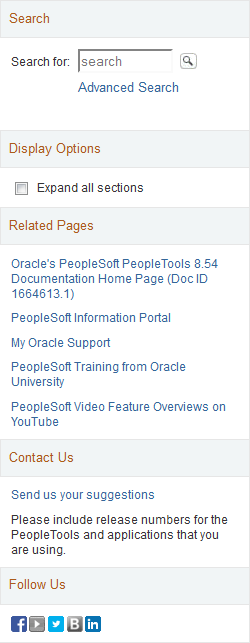
Use the home page to begin navigating to any other page in the help system. Select one of the following tabs:
|
Field or Control |
Definition |
|---|---|
| Welcome |
View information about accessing, using, and configuring the online help. |
| Product Families |
Access the online help for all of the product families that you currently have installed. Note: This help system provides documentation for PeopleSoft 9.2 and PeopleTools 8.53 and higher. Previous releases use a different help system website (called the PeopleBook Library) and are not listed on the Product Families tab. Your help administrator can configure this website to include a link to the help systems for older PeopleSoft releases. |
Use the product family navigation pages to navigate to or search for help pages, business process maps (BPMs), and streaming media for a specific product family, such as PeopleSoft Human Capital Management. Select one of the following tabs:
|
Field or Control |
Definition |
|---|---|
| Products |
Browse the help pages for all products and subjects within the product family. The products and subjects are organized into an expandable and collapsible tree view. The first level of tree nodes represents categories based on the type of information, such as core functionality, compensation management, or global payroll. Each category node contains a second level of nodes with links to the subject navigation pages for each product or subject. |
| BPMs |
Access all of the BPMs for the product family. The BPMs are organized in an expandable and collapsible tree view. The first level of tree nodes represents high-level business process areas, such as Recruiting, Development, and Deployment. Each of these nodes contains a second level of nodes with links to the BPM diagram pages. From the BPM diagrams, you can switch to the text-only versions of the BPMs as alternatives to the diagrams. Note: This tab is not available for all product families. |
| Media |
Access streaming media, such as video feature overviews and video online help, for the product family. Note: This tab is not available for all product families. |
To expand all tree nodes on a tab, select the Expand all sections check box in the Display Options portlet. Deselect the check box to collapse all tree nodes. You can also manually expand or collapse tree nodes by clicking the node title. For information about navigating through the tree view using the keyboard, see Understanding PeopleSoft Online Help Accessibility.
Image: Product Family Navigation Page - BPMs Tab
This example illustrates the tree view on the BPMs tab of a product family navigation page, which contains multiple first-level nodes, including one titled “Sales.” That node contains multiple second-level nodes, including one titled “Propose Solution.”

Image: Product Family Navigation Page - Products Tab
This example illustrates the tree view on the Products tab of a product family navigation page, which contains multiple first-level nodes, including one titled “General Information.” That node contains multiple second-level nodes, including one titled “Getting Started with PeopleTools.”

Use the subject navigation pages to access the help for a specific product or subject. Product help covers one specific product. Online help for subjects includes information that applies to the product family as a whole, such as application fundamentals help, or to a set of multiple, related products within the product family, such as call center applications.
Each navigation page includes an expandable and collapsible tree view displaying a table of contents listing all of the help pages for that product or subject. The first level in the tree is the product or subject node. That node contains a second level of nodes that group related help pages. Each group node contains a third level of nodes with links to the detailed help pages.
To expand all tree nodes in the table of contents, select the Expand all sections check box in the Display Options portlet. Deselect the check box to collapse all nodes in the table of contents. You can also manually expand or collapse tree nodes in the table of contents by clicking the node title.
Image: Subject Navigation Page
This example illustrates the tree view on a subject navigation page. The first-level node is “PeopleSoft Applications User’s Guide.” That node contains second-level nodes, including the one titled “Working With PeopleSoft Applications.” That node contains a group of third-level node, including one titled “Understanding PeopleSoft Browser-Based Applications.”
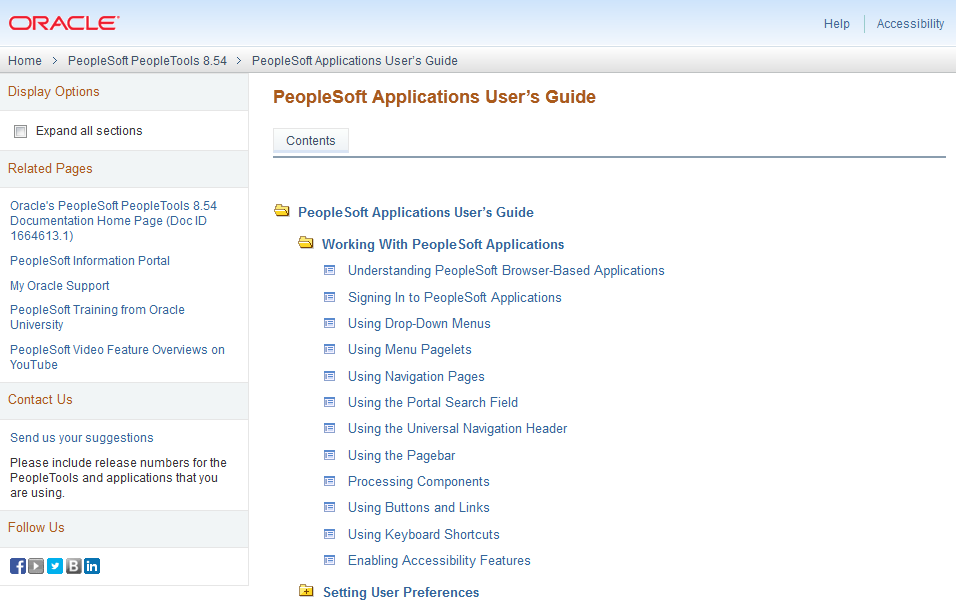
Use the BPM diagram pages to view graphical representations of the BPMs. Each BPM contains links to other BPMs and to the help for application pages or components that you use to complete the business process. All links are underlined for easy identification. In addition, each diagram includes a link at the top of the page that enables you to switch to the text-only version of the BPM for an alternative to the diagram. See Using Text-Only BPM Pages for more information.
Note: BPM pages are not available for all product families.
You can access three levels of BPMs from the product family navigation page:
|
Field or Control |
Definition |
|---|---|
| Business process area |
Select the first “Overview” BPM within a category on the BPMs tab on the product family navigation page to view a simple, high-level summary of one end-to-end process. It is a conceptual model depicting a collection of all business processes within a business process area. It contains no implementation details. Example: Recruiting category - Overview page |
| Business process |
Select any BPM after the “Overview” BPM within a category on the BPMs tab on the product family navigation page to view an overview of that business process. It is a conceptual model depicting the activities within the business process. It contains no implementation details but may include conceptual, analytic, and implementation requirements. Example: Plan Recruiting page - Overview tab |
| Activity |
On any BPM page, click any tab after the “Overview” tab to view the detailed tasks within an activity. An activity is a breakdown of one activity from the business process depicting a group of related tasks that are required to complete the activity. An activity has a specific objective and contains application-specific task flows. It can include detailed analytics and integration points. Tasks typically contain links to the help pages for the application pages or components that you use to complete the tasks. Example: Plan Recruiting page - Define Recruiting Goals and Measurements tab |
Image: BPM Diagram Page
This example illustrates a BPM diagram page for an activity. The tabs above the diagram enable you to navigate to other activities within the overall business process. The “Create sales opportunities” task box contains a link to the help page for the “Add Opportunity” application page or component.
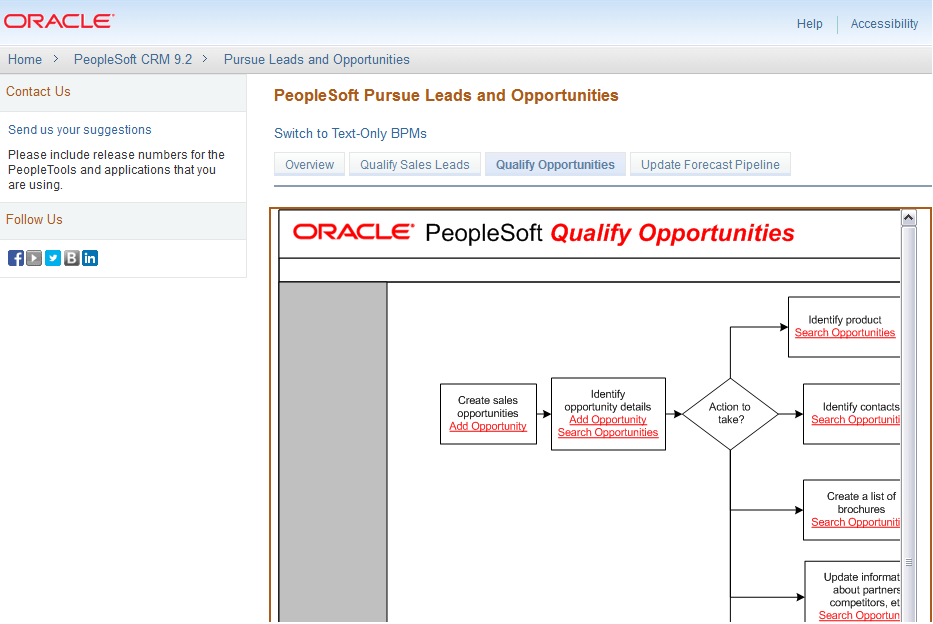
You can use the text-only BPMs as alternatives to the BPM diagrams (for example, if you use assistive technology that cannot read the BPM diagrams). To access the text-only BPMs, click the Switch to Text-Only BPMs link on the BPMs tab on the product family navigation page or on any BPM diagram page.
The text-only BPMs contain the same information as the diagrams, but in text-only format. Click a link in the list at the beginning of the page to select the activity that you want to review within the BPM. The tasks are organized into tables, which are organized into headings by role. Some roles may be listed more than once if their tasks are performed at different points in the process. Follow the task numbers in order, unless the Task Description column provides instructions to go to a different task number. Click links in the Task Description column to view detailed diagrams for those tasks or to go to the online help for those pages.
Image: Text-Only BPM Page
This example illustrates a text-only BPM page for an activity. The tabs above the text enable you to navigate to other activities within the overall business process. The “Create sales opportunities” task row in the table contains a link to the help page for the “Add Opportunity” application page or component.
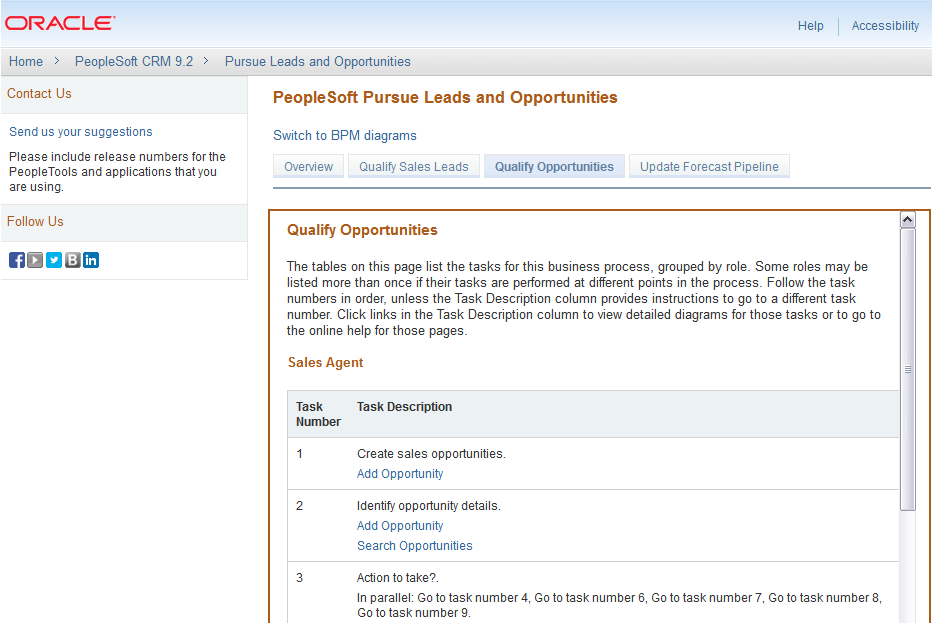
Use the help pages to read detailed descriptions of concepts, tasks, and reference materials that related to the products. Help pages may contain links to other help pages, as well as to external websites (such as oracle.com). You may also see media links pointing to video or audio recordings on YouTube or other websites.
Some pages contain expandable and collapsible sections. When you collapse all sections, you can quickly scan the section headings to find the topic that you need. When you expand all sections, you can user the browser’s Find feature to find specific words on the page.
To expand all sections, select the Expand all sections check box in the Display Options portlet. Deselect the check box to collapse all sections. You can also manually expand or collapse sections by clicking the section title.
Note: If you use assistive technology, always select the Expand all sections check box so you can easily access the entire page.
You can access related links in two locations:
|
Field or Control |
Definition |
|---|---|
| Related Pages portlet |
This portlet appears on the left side of every page. It displays links to all of the other help pages within the same table of contents group on the subject navigation page, so you don’t have to return to the subject navigation page to access a related page. The current page appears in black and is not linked, so that you can see where you are within a group of related pages. |
| Related Links section |
Related links sections can appear throughout the content of the help page. Some pages may have multiple related links sections and other pages have none. These sections contain links to related help pages or subject navigation pages anywhere within the product family. |
In addition, you can navigate between pages by clicking the Previous Page or Next Page link at the top or bottom of every help page. You can use these links to navigate through every page that is listed on the subject navigation page.
Image: Help Page
This example illustrates the content on a typical help page. This page contains two expandable and collapsible sections: Setting Use Properties and Setting Fluid Properties.
